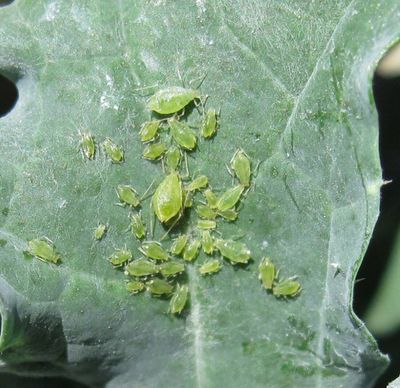Gardening: Catching aphid infestations early makes them easier to stop

I should have realized that this would be the “year of the aphid” back in March when I found my pepper starts were being attacked by the little pests.
By mid-June I was found that many people are being besieged by them on all kinds of plants.
Our cool spring fostered lush growth on the plants and the aphids are taking advantage of the tender shoots and long-lasting flowers. Aphids are the most active in temperatures between 65 and 80 degrees, just what we’ve been experiencing this year.
Aphids love tender leaves and buds on a lot of plants. They are common on cole crop vegetables (cabbage, cauliflower and broccoli), tomatoes, peppers, eggplant and roses. The Master Gardeners are seeing them on fruit trees and other shrubs. Aphids are sucking insects that feast on plant juices. Their feeding often distorts leaves and buds and stunts the growth of the plant. Bad infestations can eventually kill a plant.
Each adult can reproduce around 80 offspring in a week. The bugs are small, pear-shaped and come in colors of green, yellow, brown, red or black, depending on the species. The adults hide on the protective undersides of the leaves accompanied by frass from the molting nymphs. Under the right conditions, a nymph can grow into an adult in less than 10 days, resulting in many generations in a growing season.
So how do you get rid of them? First, catching infestations early and dealing with them is much easier than having to deal with a well-established population.
Start scouting your plants by turning over leaves on your garden walks. Most light infestations can be dislodged off the plants with a strong stream of water. Make sure you aim the jet to the underside of the leaves. Water jets like this are also a great way of controlling other insects like red spider mites on conifers later in the summer.
Learn to identify beneficial insects such as lady beetle adults and larvae, lacewing larvae, soldier beetles and syrphid fly larvae, and scout for them. If present, these insects will appear shortly after the aphids and will keep light infestations under control. Another reason for not using broad spectrum insecticides.
For bad infestations, it may be necessary to apply insecticidal soap, horticultural or neem oil sprays to smother the aphids. All are organic. The sprays are sold under a variety of trade names and are available in most garden centers. Be sure to apply to the underside of the leaves.
To prevent another aphid infestation in my vegetable starts next winter, I plan to do a better job of sanitizing my pots, plant trays and racks before I plant my seeds. This summer while it’s warm, I will wash all the dirt off my pots and trays outdoors and then run them through a 10% bleach solution to sterilize them. I’ll then wipe down my growing rack to remove any eggs that may remain, and hope for better results.